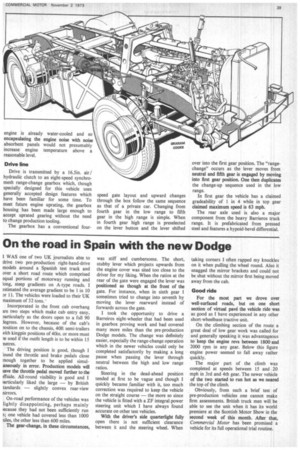On the road in Spain with the new Dodge
Page 41

If you've noticed an error in this article please click here to report it so we can fix it.
I WAS one of two UK journalists able to drive two pre-production right-hand-drive models around a Spanish test track and over a short road route which comprised 2qua1 portions of motorway running and long, steep gradients on A-type roads. I estimated the average gradient to be 1 in 10 3r 11. The vehicles were loaded to their UK maximum of 32 tons..
Incorporated in the front cab overhang Ire two steps which make cab entry easy, aarticularly as the doors open to a full 90 Jegrees. However, because of the cab's )osition on to the chassis, 40ft semi-trailers with kingpin positions of 40in. or more must )e used if the outfit length is to be within 15 metres.
The driving position is good, though I 'ound the throttle and brake pedals close inough together to be applied simulaneously in error. Production models will rave the throttle pedal moved further to the iffside. All-round visibility is good and I iarticularly liked the large — by British tandards slightly convex rear-view nirrors.
On-road performance of the vehicles was lightly disappointing, perhaps mainly iecause they had not been sufficiently run a; one vehicle had covered less than 1000 allies, the other less than 600 miles.
The gear-change, in these circumstances,
was stiff and cumbersome. The short, stubby lever which projects upwards from the engine cover was sited too close to the driver for my liking. When the ratios at the rear of the gate were engaged the lever was positioned as though at the front of the gate. For instance, when in sixth gear sometimes tried to change into seventh by moving the lever rearward instead of forwards across the gate.
I took the opportunity to drive a Barreiros eight-wheeler that had been used in gearbox proving work and had covered many more miles than the pre-production Dodge models. The change was definitely easier, especially the range-change operation which in the newer vehicles could only be completed satisfactorily by making a long pause when passing the lever through neutral between the high and low range ratios.
Steering in the dead-ahead position tended at first to be vague and though I quickly became .familiar with it, too much correction was required to keep the vehicle on the straight course — the more so since the vehicle is fitted with a ZF integral power steering unit which I have always found accurate on other test vehicles.
With the driver's side quarterlight fully open there is not sufficient clearance between it and the steering wheel. When taking corners I often rapped my knuckles on it when pulling the wheel round. Also it snagged the mirror brackets and could not be shut without the mirror first being moved away from the cab.
Good ride
For the most part we drove over well-surfaced roads, but on one short section of virtual pave the vehicle ride was as good as I have experienced in any other short-wheelbase tractive unit.
On the climbing section of the route a great deal of low gear work was called for and generally speaking. it A;V as advantageous to keep the engine revs between 1800 and 2000 rpm in any gear. Below this figure engine power seemed to fall away rather quickly.
The major part of the climb was completed at speeds between 15 and 20 mph in 3rd and 4th gear. The newer vehicle of the two started to run hot as we neared the top of the climb.
Obviously, from such a brief test of pre-production vehicles one cannot make firm assessments. British truck men will be able to see the unit when it has its world premiere at the Scottish Motor Show in the second week of this month. After that, Commercial Motor has been promised a vehicle for its full operational trial routine.
























































































































